
Wetenschap
Terwijl robots de opslag overnemen, arbeiders geduwd om zich aan te passen

In deze 17 december, 2019, foto een Amazon-robot stuurt een pakket door een parachute, het vervoeren van pakketten van arbeiders naar stortkokers die zijn georganiseerd op postcode, in een magazijn van Amazon in Goodyear, Ariz. De techgigant rolt nog steeds nieuwe modellen uit die afstammen van de Kiva-lijn, inclusief de Pegasus, een vierkant voertuig met een lopende band er bovenop die je in de vroege ochtendploeg kunt vinden in een magazijn in de buitenwijk Goodyear in Phoenix. (AP Foto/Ross D. Franklin)
Raad eens wie er in hun dagelijks leven gewend raakt aan het werken met robots? Dezelfde magazijnmedewerkers voorspelden ooit dat ze hun baan zouden verliezen door mechanische vervangingen.
Maar je werk zij aan zij met robots doen is niet eenvoudig. Volgens hun makers de machines moeten de meest alledaagse en fysiek inspannende taken op zich nemen. In werkelijkheid, ze creëren ook nieuwe vormen van stress en spanning in de vorm van blessures en het ongemak van dichtbij werken met mobiele apparaten van een halve ton die zichzelf regisseren.
"Ze wegen veel, "Amazon-werknemer Amanda Taillon zei tijdens de pre-kerststorm in een bedrijfsmagazijn in Connecticut. In de buurt, een vloot van zes meter hoge zwervende robotplanken die achter een hek met kettingschakels waren geritst.
Taillons taak is om een kooi binnen te gaan en de magazijnrobots op wielen van Amazon lang genoeg te temmen om een gevallen speelgoed op te rapen of een verkeersopstopping te verlichten. Ze doet een oplichtende gereedschapsriem om die werkt als het krachtveld van een superheld, de dichtstbijzijnde robots opdracht geven abrupt te stoppen en de anderen te vertragen of hun routes aan te passen.
"Als je daar bent, en je kunt ze horen bewegen, maar je kunt ze niet zien, het is als, 'Waar komen ze vandaan?', "zei ze. "Het is in het begin een beetje zenuwslopend."

In deze 17 december, 2019, foto tientallen Amazon-robots vervoeren pakketten van arbeiders naar stortkokers die zijn georganiseerd op postcode, in een magazijn van Amazon in Goodyear, Ariz. Amazon en zijn rivalen eisen steeds vaker dat magazijnmedewerkers wennen aan het werken met robots. Het bedrijf heeft nu meer dan 200, 000 robotvoertuigen die het "drives" noemt die goederen door zijn leveringscentra in de VS verplaatsen (AP Photo/Ross D. Franklin)
Taillon zegt dat ze gewend is geraakt aan het werken met robots - iets wat Amazon en zijn rivalen steeds vaker van magazijnmedewerkers eisen. Amazon heeft nu meer dan 200, 000 robotvoertuigen die het "drives" noemt die goederen door zijn delivery-fulfillment-centra in de VS verplaatsen. Dat is het dubbele van het aantal dat het vorig jaar had en meer dan 15, 000 eenheden in 2014.
Zijn rivalen hebben kennis genomen, en velen voegen hun eigen robots toe in een race om de productiviteit te verhogen en de kosten te verlagen.
Zonder deze snel bewegende pods, robotarmen en andere vormen van magazijnautomatisering, retailers zeggen dat ze niet in staat zouden zijn om te voldoen aan de vraag van de consument naar pakketten die de dag nadat je ze online hebt besteld op de stoep kunnen belanden.
Maar hoewel de vrees dat robots menselijke arbeiders zullen vervangen niet is uitgekomen, er zijn groeiende zorgen dat het bijhouden van het tempo van de nieuwste kunstmatige-intelligentietechnologie een negatieve invloed heeft op de gezondheid van menselijke werknemers, veiligheid en moraal.

In deze 17 december, 2019, foto Joseph Salinas plaatst pakketten op Amazon-robots, het vervoeren van pakketten van arbeiders naar stortkokers die zijn georganiseerd op postcode, in een magazijn van Amazon in Goodyear, Ariz. Magazijnen aangedreven door robotica en AI-software leiden tot menselijke burn-out door meer werk toe te voegen en de druk op werknemers op te voeren om hun prestaties te versnellen, zei Beth Gutelius, die stedelijke economische ontwikkeling bestudeert aan de Universiteit van Illinois in Chicago en magazijniers in de VS heeft geïnterviewd (AP Photo/Ross D. Franklin)
Magazijnen aangedreven door robotica en AI-software leiden tot menselijke burn-out door meer werk toe te voegen en de druk op werknemers op te voeren om hun prestaties te versnellen, zei Beth Gutelius, die stedelijke economische ontwikkeling bestudeert aan de Universiteit van Illinois in Chicago en magazijniers in de VS heeft geïnterviewd.
Het is niet zo dat werknemers niet worden opgeleid om veilig met robots te werken. "Het probleem is dat het erg moeilijk wordt om dat te doen als de productiviteitsnormen zo hoog zijn, " ze zei.
Een groot deel van de hausse in magazijnrobotica vindt zijn oorsprong in Amazon's aankoop van 775 miljoen dollar van de start-up Kiva Systems uit Massachusetts in 2012. het bouwen van Amazon's robotarmada.

In deze 17 december, 2019, foto Amazon-robots verplaatsen zich met pakketten over de magazijnvloer voordat ze de juiste afleverkoker vinden, het vervoeren van pakketten van arbeiders naar stortkokers die zijn georganiseerd op postcode, in een magazijn van Amazon in Goodyear, Ariz. Amazon en zijn rivalen eisen steeds vaker dat magazijnmedewerkers wennen aan het werken met robots. Het bedrijf heeft nu meer dan 200, 000 robotvoertuigen die het "drives" noemt die goederen door zijn leveringscentra in de VS verplaatsen (AP Photo/Ross D. Franklin)
Amazon's Kiva-aankoop "zet de toon voor alle andere retailers om op te staan en op te letten, " zei Jim Liefer, CEO van de startup Kindred AI in San Francisco, which makes an artificially intelligent robotic arm that grasps and sorts items for retailers such as The Gap.
A rush of venture capital and private sector investment in warehouse robotics spiked to $1.5 billion a year in 2015 and has remained high ever since, said Rian Whitton, a robotics analyst at ABI Research.
Canadian e-commerce company Shopify spent $450 million this fall to buy Massachusetts-based startup 6 River Systems, which makes an autonomous cart nicknamed Chuck that can follow workers around a warehouse. Other mobile robot startups are partnering with delivery giants such as FedEx and DHL or retailers such as Walmart.
Amazon this year bought another warehouse robotics startup, Colorado-based Canvas Technology, which builds wheeled robots guided by computer vision. Such robots would be more fully autonomous than Amazon's current fleet of caged-off vehicles, which have to follow bar codes and previously mapped routes within warehouses.
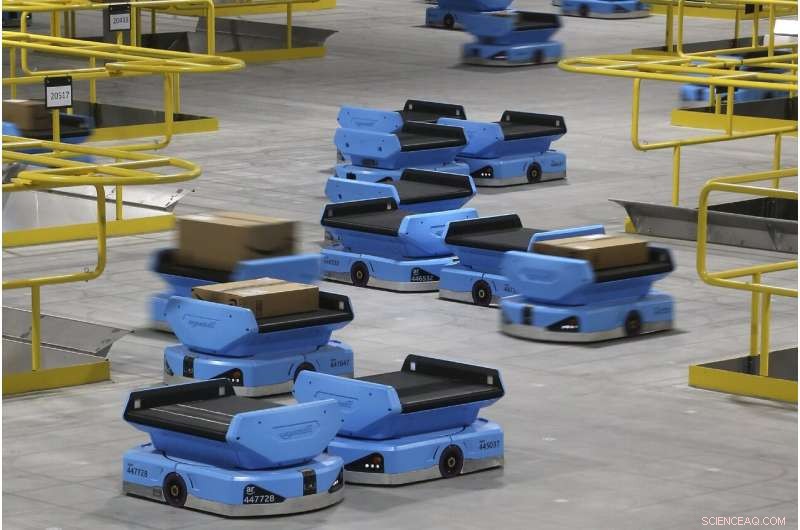
In this Dec. 17, 2019, photo Amazon robots zip along the a warehouse floor, transporting packages from workers to chutes that are organized by zip code, at an Amazon warehouse facility in Goodyear, Ariz. Amazon and its rivals are increasingly requiring warehouse employees to get used to working with robots. The company now has more than 200, 000 robotic vehicles it calls "drives" that are moving goods through its delivery-fulfillment centers around the U.S. (AP Photo/Ross D. Franklin)
The tech giant is also still rolling out new models descended from the Kiva line, including the Pegasus, a squarish vehicle with a conveyor belt on top that can be found working the early-morning shift at a warehouse in the Phoenix suburb of Goodyear, Arizona. A crisscrossing fleet of robots carries packaged items across the floor and drops them into chutes based on the zip code of their final destination.
All of this is transforming warehouse work in a way that the head of Amazon Robotics says can "extend human capability" by shifting people to what they are best at:problem-solving, common sense and thinking on their feet.
"The efficiencies we gain from our associates and robotics working together harmoniously—what I like to call a symphony of humans and machines working together—allows us to pass along a lower cost to our customer, " said Tye Brady, Amazon Robotics' chief technologist.

In this Dec. 17, 2019, photo an Amazon robot sends a package down a chute, transporting packages from workers to chutes that are organized by zip code, at an Amazon warehouse facility in Goodyear, Ariz. Warehouses powered by robotics and AI software are leading to human burnout by adding more work and upping the pressure on workers to speed up their performance, said Beth Gutelius, who studies urban economic development at the University of Illinois at Chicago and has interviewed warehouse operators around the U.S. (AP Photo/Ross D. Franklin)
Brady said worker safety remains the top priority and ergonomic design is engineered into the systems at the beginning of the design stage. Gutelius, the University of Illinois researcher, said that the aspiration for symphonic human-machine operations is not always working out in practice.
"It sounds quite lovely, but I rarely hear from a worker's perspective that that's what it feels like, " ze zei.
Gutelius co-authored a report published this fall that found new warehouse technology could contribute to wage stagnation, higher turnover and poorer quality work experiences because of the way AI software can monitor and micro-manage workers' behaviors.
A recent journalistic investigation of injury rates at Amazon warehouses from The Center for Investigative Reporting's Reveal found that robotic warehouses reported more injuries than those without.
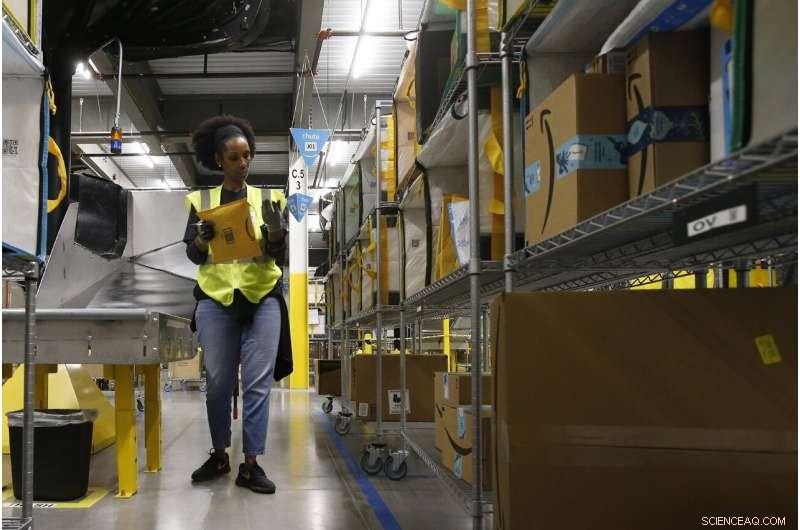
In this Dec. 17, 2019, photo Tahsha Sydnor stows packages into special containers after Amazon robots deliver separated packages by zip code at an Amazon warehouse facility in Goodyear, Ariz. Amazon and its rivals are increasingly requiring warehouse employees to get used to working with robots. The company now has more than 200, 000 robotic vehicles it calls "drives" that are moving goods through its delivery-fulfillment centers around the U.S. (AP Photo/Ross D. Franklin)
Reveal looked at records from 28 Amazon warehouses in 16 states and found that the overall rate of serious injuries was more than double the warehousing industry average. Amazon has countered it's misleading to compare its rate with rivals because of the company's "aggressive stance on recording injuries no matter how big or small."
The Reveal report also found a correlation between robots and safety problems, such as in Tracy, Californië, where the serious injury rate nearly quadrupled in the four years after robots were introduced.
Melonee Wise, CEO of California-based Fetch Robotics, which sells its autonomous robotic carts to retailers and other clients, credits Amazon's Kiva acquisition for propelling innovation in the industry.
But she said that Amazon's system forces workers to do "un-ergonomic moves" such as reaching up high or crouching down to pick out and stow inventory into the shelves-on-wheels.
-
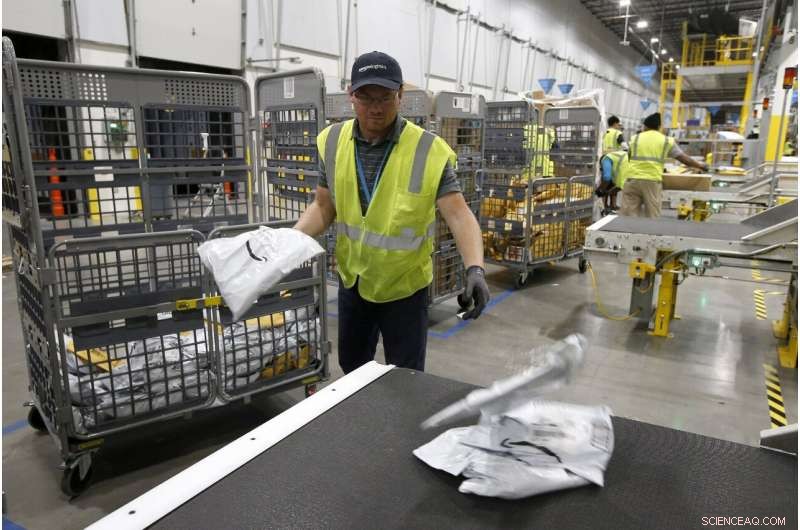
In this Dec. 17, 2019, photo Steven Smith places packages onto a conveyor prior to Amazon robots transporting packages to chutes that are organized by zip code, at an Amazon warehouse facility in Goodyear, Ariz. (AP Photo/Ross D. Franklin)
-
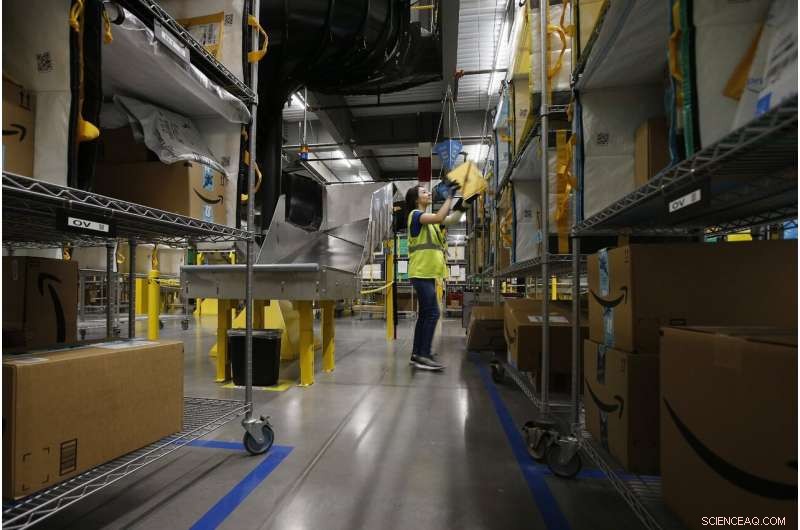
In this Dec. 17, 2019, photo Jocelyn Nieto stows packages into special containers after Amazon robots deliver separated packages by zip code at an Amazon warehouse facility in Goodyear, Ariz. Doing your job side-by-side with robots isn't easy. According to their makers, the machines should take on the most mundane and physically strenuous tasks. In reality, they're also creating new forms of stress and strain in the form of injuries and just the unease of working in close quarters with mobile half-ton devices that direct themselves. (AP Photo/Ross D. Franklin)
-
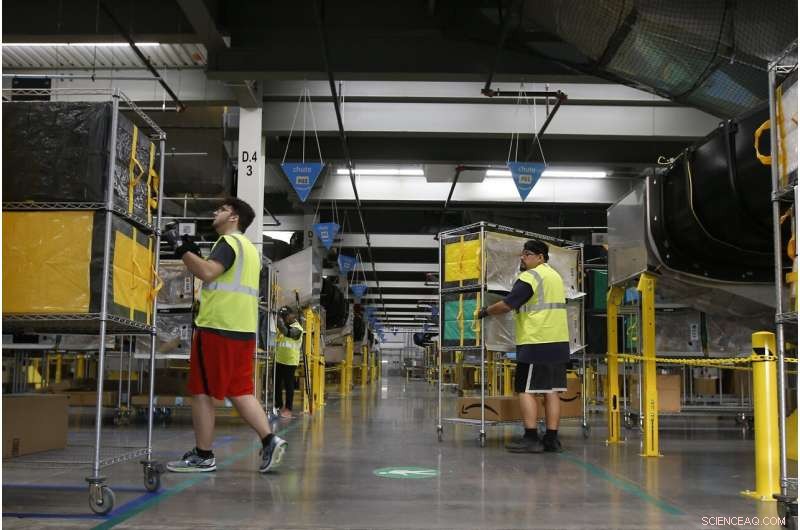
In this Dec. 17, 2019, photo Amazon workers bring stowed containers to their specific trucks after Amazon robots deliver separated packages by zip code at an Amazon warehouse facility in Goodyear, Ariz. (AP Photo/Ross D. Franklin)
"They have robots that live in cages, " she said. "Our robots are designed to work safely around people, which is a very large distinction between the two systems."
Amazon hasn't disclosed how its safety record at robot-powered warehouses compares to those without. But company officials remain optimistic that Amazon workers are adapting to the new technology.
At a visit with a reporter earlier in December to the warehouse in North Haven, Connecticut, Brady was explaining the workings of a powerful robotic arm called a "palletizer" when crates it was stacking on a pallet started tumbling over. Unfazed by the temporary malfunction, he watched as an employee disabled the machine, discovered an apparent structural weakness in the pallet, adjusted the stack of crates and let the robot get back to work.
"His ability to problem-solve that was like this, " Brady said, enthusiastically snapping his fingers. "What I love about that is it's humans and machines working together."
© 2019 The Associated Press. Alle rechten voorbehouden.
 Betere benzeendetectie op laserpunt
Betere benzeendetectie op laserpunt Hoe de aanwezigheid van insecticiden in groenten en fruit te detecteren
Hoe de aanwezigheid van insecticiden in groenten en fruit te detecteren Heavy metal donder:Eiwit kan worden ingeschakeld om elektriciteit als een metaal te geleiden
Heavy metal donder:Eiwit kan worden ingeschakeld om elektriciteit als een metaal te geleiden Team ontwikkelt gasdetectietechnologie die een revolutie teweeg kan brengen in de milieu- en medische diagnostiek
Team ontwikkelt gasdetectietechnologie die een revolutie teweeg kan brengen in de milieu- en medische diagnostiek Aanpasbaar synthetisch antibioticum verslaat resistente bacteriën
Aanpasbaar synthetisch antibioticum verslaat resistente bacteriën
 Opwarming van de aarde van 1,5C of 2C:de ondergrens zou het overstromingsgevaar verminderen
Opwarming van de aarde van 1,5C of 2C:de ondergrens zou het overstromingsgevaar verminderen De laatste omkering van het magnetische veld van de aarde duurde veel langer dan ooit werd gedacht
De laatste omkering van het magnetische veld van de aarde duurde veel langer dan ooit werd gedacht Stromingen in de Atlantische Oceaan nemen af,
Stromingen in de Atlantische Oceaan nemen af,  Volgende 10 jaar cruciaal voor het behalen van klimaatdoelstellingen
Volgende 10 jaar cruciaal voor het behalen van klimaatdoelstellingen Bezorgdheid groeit over besmet zuiveringsslib dat op akkers wordt verspreid
Bezorgdheid groeit over besmet zuiveringsslib dat op akkers wordt verspreid
Hoofdlijnen
- 10 slechtste aanpassingen in het dierenrijk
- Hoe een tRNA-sequentie uit een DNA-sequentie te krijgen
- Wat is een voorbeeld in een levend systeem van hoe moleculair van vorm is?
- Iraakse dierenliefhebbers gaan online om zwerfdieren in Bagdad te redden
- Relatie tussen DNA-basen Genen, eiwitten en eigenschappen
- Nidovirussen brengen overtollig genen tot expressie en coderen voor meer eiwitten dan eerder werd aangenomen, studie vondsten
- Nieuwe studie werpt licht op de rol van de zon bij het verminderen van schimmelziekte van mangofruit
- Plantenziekte bestrijden bij warme temperaturen houdt voedsel op tafel
- 5 geheimen om erachter te komen Whatll zijn op het examen
- De grootste uitdaging van de nieuwe Tesla-voorzitters is het beheersen van Musk

- VK doet eerste veroordeling voor 3D-geprint pistool

- Een raamwerk voor AI-aangedreven agile projectmanagement

- Een licht schijnen op de betrouwbaarheid van elektriciteit in Sub-Sahara Afrika

- Robotbarista's zijn het nieuwste front in de automatisering van S. Korea
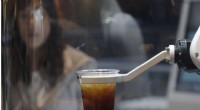
 Napoleons nederlaag bij Waterloo mede veroorzaakt door Indonesische vulkaanuitbarsting
Napoleons nederlaag bij Waterloo mede veroorzaakt door Indonesische vulkaanuitbarsting Venetië onder water terwijl uitzonderlijk getij door kanaalstad raast
Venetië onder water terwijl uitzonderlijk getij door kanaalstad raast Wetenschap in een vliegtuig - ESA's volgende parabolische vluchtcampagne
Wetenschap in een vliegtuig - ESA's volgende parabolische vluchtcampagne Honeywell onthult plan voor krachtigste kwantumcomputer
Honeywell onthult plan voor krachtigste kwantumcomputer Ziekteverwekkers omzetten in hulpmiddelen voor gezondheid en een beter leven
Ziekteverwekkers omzetten in hulpmiddelen voor gezondheid en een beter leven Het verschil tussen genomisch DNA en plasmide-DNA
Het verschil tussen genomisch DNA en plasmide-DNA  Studie verbindt klimaatbeleid, koolstofemissies van permafrost
Studie verbindt klimaatbeleid, koolstofemissies van permafrost Galactische fonteinen en carrousels:orde die voortkomt uit chaos
Galactische fonteinen en carrousels:orde die voortkomt uit chaos
- Elektronica
- Biologie
- Zonsverduistering
- Wiskunde
- French | Italian | Spanish | Portuguese | Swedish | German | Dutch | Danish | Norway |

-
Wetenschap © https://nl.scienceaq.com

